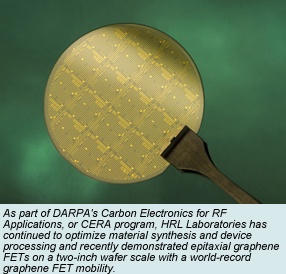May 21 2009
HRL Laboratories, LLC, announced today it reached another milestone in the Carbon Electronics for RF Applications, or CERA program, which seeks to exploit the unique physical characteristics of graphene carbon to create electronic components that will enable unprecedented capabilities in high-bandwidth communications, imaging and radar systems.

Sponsored by the Defense Advanced Research Projects Agency and under the management of the Space and Naval Warfare Systems Center, HRL is collaborating with a group of universities, commercial companies and the Naval Research Laboratory on the CERA program.
Imaging, radar and communications capabilities have been hindered by the cost of RF components, limited resolution and high power dissipation. Graphene—a single layer of carbon atoms densely packed in a tight, honeycomb crystalline lattice configuration—could be a game-changing enhancement to RF components because of its extremely high current-carrying capacity, excellent thermal conductivity and low-voltage operational potential. A graphene-on-silicon platform could revolutionize a number of applications because of its high performance, scalability, integration and low cost.
HRL began work on CERA in July 2008, reaching an initial milestone in December by successfully integrating and demonstrating the world's first graphene FETs in the RF frequency range. Researchers have now taken the technology to a new level. The team has continued to optimize material synthesis and device processing and recently demonstrated epitaxial graphene FETs on a two-inch wafer scale.
According to HRL Senior Scientist and CERA Program Manager Dr. Jeong-Sun Moon, the breakthrough is significant and continues to confirm the team's approach. "Using a single layer of epitaxially grown graphene, these transistors demonstrate simultaneous world-record performance in key device parameters for the first time," Moon said. "They have world-record field effect mobility of ~6000 cm2/Vs, which is six to eight times higher than current state-of-the-art silicon n-MOSFETs (metal-oxide semiconductor field effect transistors)." The epitaxial graphene transistors also show excellent I-V saturation behaviors with the highest reported Ion/Ioff ratio of 19.
Moon is confident the process and technology will continue to progress to meet the program's final Phase 1 metric: >10,000 cm2/Vs Hall mobility. "The results and rate of progress validate our technical approach," he said. "We are confident that we will soon meet the extremely challenging graphene transistor Phase I metrics."